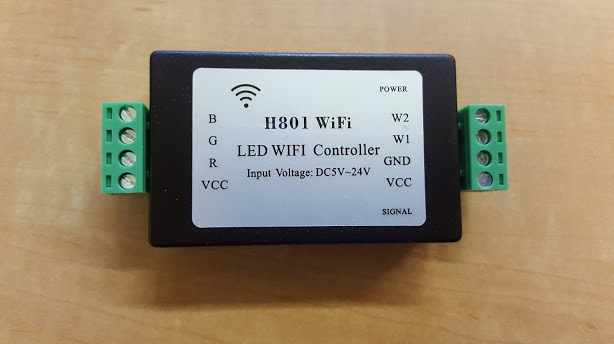
Available from:
Banggood.com
Aliexpress.com
| GPIO # | Component |
|---|---|
| GPIO00 | User |
| GPIO01 | Led 1 |
| GPIO02 | User |
| GPIO03 | User |
| GPIO04 | PWM 5 |
| GPIO05 | Led_i 2 |
| GPIO09 | None |
| GPIO10 | None |
| GPIO12 | PWM 3 |
| GPIO13 | PWM 2 |
| GPIO14 | PWM 4 |
| GPIO15 | PWM 1 |
| GPIO16 | None |
| GPIO17 | None |
{"NAME":"H801","GPIO":[1,288,1,1,420,321,0,0,418,417,419,416,0,0],"FLAG":0,"BASE":20}
Hardware
The chip used on this board is the ESP8266EX. 5 PWM outputs are connected to DTU35N06 MOSFETs to drive the 5 output channels (RGB + W1 + W2).
| Function | ESP8266 Pin | Channel |
|---|---|---|
| R | GPIO 15 | PWM1 |
| G | GPIO 12 | PWM2 |
| B | GPIO 13 | PWM3 |
| CW | GPIO 14 | PWM4 |
| WW | GPIO 04 | PWM5 |
| LED D1 (red) | GPIO 05 | |
| LED D2 (green) | GPIO 01 |
Serial Flashing
Please see the Hardware Preparation page for general instructions.

You need to access the serial interface. The unpopulated serial header (3V3, RX, TX, GND) are available in the middle of the PCB, right next to J3. Note: the RX and TX pins are labelled from the terminal’s perspective, not from the perspective of the ESP chip. This means you should connect the RX and TX pins from your serial-to-USB adapter to the RX and TX pins on the board respectively, not crossing them over!
To place the board into flashing mode, you will need to short J3 and GND. This can remain shorted while flashing is in progress, but remember to remove the short when done.
Configuration over serial terminal
Most boards supported by the Tasmota firmware use GPIO01 for serial TX. The H801, as shown in the image above, uses GPIO02. As the serial RX is still the same as for other boards, it is possible for Tasmota to read from the serial connection but anything written will not be sent to your terminal. Blindly type the following command to set Tasmota to the H801 module.
module 20
After a reboot it will automatically switch to using GPIO02 for serial TX allowing setup to proceed: See #2155 for more details.
Please be aware that some of the H801 modules were sold with only 512kB of flash. You can check whether yours is affected by using esptool, with the flash_id command. If you only have 512kB of flash, you can still build your own firmware, but will have to remove components that you do not need, in order to reduce the size of the firmware binary. For an example, see this issue
Known Issue
While powering up there is a short, but bright flash of light from the connected LED strip.
For more info about H801 read: A closer look at the H801 LED WiFi Controller by Tinkerman




